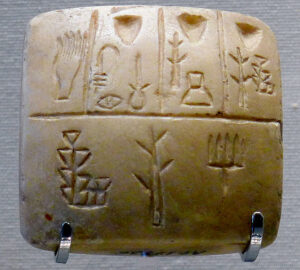Hello! Welcome to my first post about the ancient language of the Sumerians. I’ve been watching some lessons and doing some research this month, and I thought I would share what I’ve learned so far.
(If you would like to watch the lessons I’ve gleaned most of this information from, you can find them here. The teacher is Gabriele Barra, and the YouTube channel is called Learn Egyptian and Sumerian.)
Sumerian was the language of the Sumerian people of Mesopotamia throughout the 3rd millennium BC/BCE, but after around 2000 BC/BCE it was mostly used for administration, organization, and literary purposes. It was also the literary language of Babylonians and Assyrians for some time. It was written as cuneiform (wedge-shaped symbols etched into clay), and this form of writing was adopted and adapted by many peoples in surrounding regions. However, the Sumerian language itself doesn’t have any known relatives or “cognates” – in other words, we don’t know which language Sumerian branched off from, nor do we know of any languages that branched off from Sumerian. Other regions only seem to have adopted the writing form, not the language.
Sumerian cuneiform used logographic signs (one symbol stands for a whole word) as well as syllabic signs (one symbol stands for one syllable within a word in combination with other signs), and the same sign was sometimes used for different words in different contexts (these different meanings are assigned a number when transliterating into the Roman alphabet). We know roughly how Sumerian sounded because the Akkadians compiled a sort of dictionary complete with pronunciation guides, but whatever consonant or vowel sounds Sumerian had that the Akkadian language couldn’t replicate are lost to us.

Sumerian cuneiform (image from Wikipedia)
Interestingly, Sumerian is a nongendered language (nouns are not assigned gender), but classifies nouns as either persons (humans and gods) or objects (animals and inanimate objects). These two classes of words have different rules for pluralization. It is also an agglutinative language (words have an unchanging core to which prefixes and suffixes that change the meaning are added). An entire sentence can be expressed in a single word consisting of a core and several prefixes and suffixes. Korean, Japanese, Hungarian, and Turkish are modern examples of agglutinative languages.
I obviously won’t become proficient enough in Sumerian to read texts in the original cuneiform this month, but I’m very much enjoying my study of the history and analysis of this fascinating language. Have you ever studied Sumerian? If you have any insights to share, I would love to hear them. I’ll share another update on my Sumerian studies later this month.